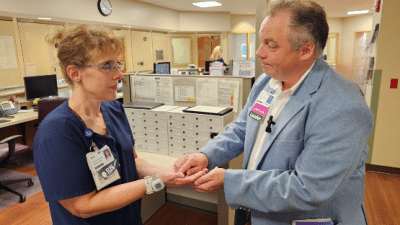
The new measures of effectiveness are a “quantum leap” improvement over current metrics, said Steven Stern, U.Va.’s Merrill Bankard Professor of Economics.
The goal of vocational rehabilitation services is to expand employment opportunities for individuals with a spectrum of disabling conditions, from mental illness and cognitive impairments to physical impairments, autism and learning disabilities. Services offered range from basic skills training through employment supports like transportation to and from jobs.
To measure the effectiveness of these services, the new approach harnesses 10 years of anonymized longitudinal data on each person who receives vocational rehabilitation services – tracking his or her wages and labor force data from three years before entering a program to seven years after entering.
That rich long-term data – created by merging two state data sets – is analyzed by econometric modeling software created by Stern and fellow U.Va. economics professor John Pepper. After a decade of development by Stern, Pepper and colleagues at the University of Richmond and the Virginia Department of Aging and Rehabilitative Services, the modeling software has evolved to handle the large statistical variations observed across different types of disabilities and across the range of interventions, including diagnosis and evaluation, education, job training, and even restorative services like providing an artificial limb.
“What works is specific to the type of disability the individual has, and there is not really an average person in these programs,” Stern said. “Participants tend to be quite unique. So the software must handle these statistical challenges.”
For instance, Stern said, restorative services are the most valuable for those with physical impairment, while education services are most useful for those with cognitive impairments.
Across all groups and types of services studied thus far in Virginia, median rates of return are very high – “about 40 percent per year, and much higher for some groups,” Stern said. These benefits often become more pronounced a few years after leaving a program, which is why the use of long-term data is crucial, he said.
For example, participants in Virginia’s Postsecondary Education Rehabilitation Transition program, supported by the Virginia Department of Education and administered by the Virginia Department for Aging and Rehabilitative Services at its Woodrow Wilson Rehabilitation Center in Fishersville, earn on average twice as much in their first 10 years in the workforce than if they had not taken part in the program, Stern explained.
This research collaboration “has clearly identified the value of our vocational rehabilitation program with data confirming the long-term return on investment of our funds,” said Bill Hazel, Virginia Secretary of Health and Human Resources.
Many states and programs currently measure effectiveness by simply reporting a starting salary in the year after someone exits a vocational rehabilitation service. “That’s not a good way to measure effectiveness,” Stern said.
The new grant will enable the team to assess the effectiveness of vocational rehabilitation programs in five additional states – Delaware, Kentucky, Maryland, Oklahoma and Texas – by working directly with the state agencies overseeing those programs.
With the new grant, Stern, Pepper and colleagues will create a user-friendly, Web-based version of their Rate of Return Estimator software, enabling state agencies across the nation to assess the impact and cost effectiveness of different vocational rehabilitation services.
Ultimately, the goal is to enable “turnkey” analysis, Stern said, that can generate rigorous and credible estimates for any size agency, for individuals with virtually any type of disability, for different types of services.
All states are required to collect the same longitudinal data sets that the research team harnessed to study vocational rehabilitation services in Virginia, Stern said, so the new analysis should work for any state.
Vocational rehabilitation programs are largely funded by a federal-state partnership, administered by the federal Rehabilitation Services Administration, which currently gives approximately $3 billion annually to state agencies to provide vocational rehabilitation services.
The team’s new approach is coming just as state legislatures are increasingly seeking data on the effectiveness of vocational rehabilitation programs, Stern said. “Both critics and defenders of vocational rehabilitation services will finally have better data to evaluate the cost effectiveness of these programs.”
On Nov. 25, Virginia Gov. McAuliffe announced the nearly $2.5 million federal grant to the University of Richmond and its partners: U.Va., the Virginia Department for Aging and Rehabilitative Services, the Virginia Department for the Blind and Vision Impaired, and the George Washington University Center for Rehabilitation Counseling Research and Education.
“This truly collaborative project is bearing fruit as we look at the return on investment of this publicly funded program at the state level,” said McAuliffe in a press release announcing the grant. “This research is demonstrating evidence-based approaches to help people with disabilities enter the workforce.”
Dr. Robert Schmidt, professor and chair of the economics department in the University of Richmond’s Robins School of Business, is the principal investigator on the $2,498,878, five-year grant from the U.S. Department of Education’s National Institute on Disability and Rehabilitation Research.
Stern and Pepper have been studying long-term employment outcomes for vocational rehabilitation clients for about a decade with Schmidt and his colleague, the late David Dean, a University of Richmond professor of economics, and others, supported by three prior grants. This line of research has resulted in three published papers thus far, and at least six other papers under way.
The National Council on Rehabilitation Education recently awarded the Virginia Department for Aging and Rehabilitative Services its annual President’s Award for Excellence in Vocational Rehabilitation for outstanding work on return on investment in vocational rehabilitation.
Echoing the award, Stern said the department “has been a leader in effectiveness research for many years, and the results of this grant will be a national model.”










